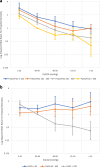The interaction between arterial oxygenation and carbon dioxide and hospital mortality following out of hospital cardiac arrest: a cohort study
- PMID: 32532312
- PMCID: PMC7290139
- DOI: 10.1186/s13054-020-03039-6
The interaction between arterial oxygenation and carbon dioxide and hospital mortality following out of hospital cardiac arrest: a cohort study
Abstract
Background: Outcomes following out of hospital cardiac arrest (OHCA) are poor. The optimal arterial oxygen and carbon dioxide (PaCO2) levels for managing patients following OHCA are unknown. We hypothesized that abnormalities in arterial oxygenation (PaO2/FiO2 ratio or PaO2) and PaCO2 would be associated with hospital mortality following OHCA. We hypothesized that PaCO2 would significantly modify the oxygenation-mortality relationship.
Methods: This was an observational cohort study using data from OHCA survivors admitted to adult critical care units in England, Wales and Northern Ireland from 2011 to 2018. Logistic regression analyses were performed to assess the relationship between hospital mortality and oxygenation and PaCO2.
Results: The analysis included 23,625 patients. In comparison with patients with a PaO2/FiO2 > 300 mmHg, those with a PaO2/FiO2 ≤ 100 mmHg had higher mortality (adjusted OR, 1.79; 95% CI, 1.48 to 2.15; P < 0.001). In comparison to hyperoxemia (PaO2 > 100 mmHg), patients with hypoxemia (PaO2 < 60 mmHg) had higher mortality (adjusted OR, 1.34; 95% CI, 1.10 to 1.65; P = 0.004). In comparison with normocapnia, hypercapnia was associated with lower mortality. Hypocapnia (PaCO2 ≤ 35 mmHg) was associated with higher mortality (adjusted OR, 1.91; 95% CI, 1.63 to 2.24; P < 0.001). PaCO2 modified the PaO2/FiO2-mortality and PaO2-mortality relationships, though these relationships were complex. Patients who were both hyperoxic and hypercapnic had the lowest mortality.
Conclusions: Low PaO2/FiO2 ratio, hypoxemia and hypocapnia are associated with higher mortality following OHCA. PaCO2 modifies the relationship between oxygenation and mortality following OHCA; future studies examining this interaction are required.
Keywords: Carbon dioxide; Critical care; Interaction; Mortality; Out of hospital cardiac arrest; Oxygen.
Conflict of interest statement
PMcG has previously received Honoraria from Teleflex.
MSH is supported by the National Institute for Health Research Clinician Scientist Award (CS-2016-16-011). The views expressed in this publication are those of the author(s) and not necessarily those of the NHS, the National Institute for Health Research or the Department of Health. The funding source did not have any role in the design, conduct or interpretation of study results.
DH declares that he has no conflict of interests.
JL declares that he has no conflict of interests.
DMcA declares that he has no conflict of interests.
Figures



Comment in
-
The interaction between arterial oxygenation and carbon dioxide and hospital mortality following out of hospital cardiac arrest: a cohort study-do not dismiss confounders!Crit Care. 2020 Sep 3;24(1):544. doi: 10.1186/s13054-020-03196-8. Crit Care. 2020. PMID: 32883315 Free PMC article. No abstract available.
References
-
- Nolan JP, Soar J, Cariou A, et al. European Resuscitation Council and European Society of Intensive Care Medicine Guidelines for Post-resuscitation Care 2015: section 5 of the European Resuscitation Council Guidelines for Resuscitation 2015. Resuscitation. 2015;95:202–222. doi: 10.1016/j.resuscitation.2015.07.018. - DOI - PubMed
Publication types
MeSH terms
Substances
LinkOut - more resources
Full Text Sources

